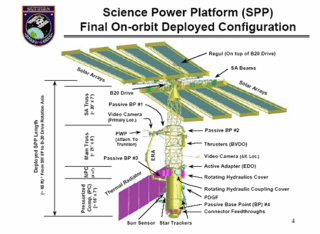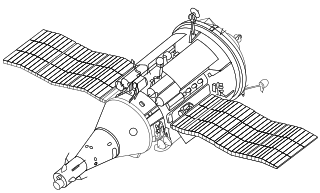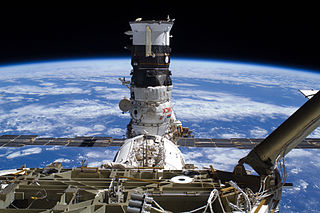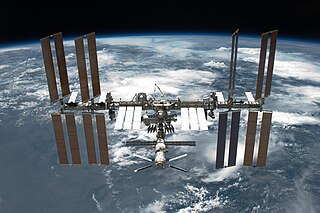
The Salyut programme was the first space station programme, undertaken by the Soviet Union. It involved a series of four crewed scientific research space stations and two crewed military reconnaissance space stations over a period of 15 years, from 1971 to 1986. Two other Salyut launches failed. In one respect, Salyut had the space-race task of carrying out long-term research into the problems of living in space and a variety of astronomical, biological and Earth-resources experiments, and on the other hand, the USSR used this civilian programme as a cover for the highly secretive military Almaz stations, which flew under the Salyut designation. Salyut 1, the first station in the program, became the world's first crewed space station.

The Almaz program was a highly secret Soviet military space station program, begun in the early 1960s.

Zvezda, also known as the Zvezda Service Module, is a module of the International Space Station (ISS). It was the third module launched to the station, and provided all of the station's life support systems, some of which are supplemented in the US Orbital Segment (USOS), as well as living quarters for two crew members. It is the structural and functional center of the Russian Orbital Segment (ROS), which is the Russian part of the ISS. Crew assemble here to deal with emergencies on the station.

Zarya, also known as the Functional Cargo Block, is the inaugural component of the International Space Station (ISS). Launched on 20 November 1998 atop a Proton-K rocket, the module would serve as the ISS's primary source of power, propulsion, and guidance during its early years. As the station has grown, Zarya's role has transitioned primarily to storage, both internally and in its external fuel tanks. A descendant of the TKS spacecraft used in the Salyut programme, Zarya was built in Russia but its construction was financed by the United States. Its name, meaning "sunrise," symbolizes the beginning of a new era of international space cooperation.

The Science Power Platform was a planned Russian element of the International Space Station (ISS) that was intended to be delivered to the ISS by a Russian Proton rocket or Zenit rocket but was shifted to launch by Space Shuttle as part as a tradeoff agreement on other parts of the ISS.
The Russian Research Module (RM) was to be a Russian component of the International Space Station (ISS) that provided facilities for Russian science experiments and research.

The TKS spacecraft was a Soviet spacecraft conceived in the late 1960s for resupply flights to the military Almaz space station.

Pirs(Russian: Пирс, meaning "pier") – also called Stykovochny Otsek 1 and DC-1 – was a Russian module on the International Space Station (ISS). Pirs was launched on 14 September 2001, and was located on the Zvezda module of the station. It provided the ISS with one docking port for Soyuz and Progress spacecraft, and allowed egress and ingress for spacewalks by cosmonauts using Russian Orlan space suits. Pirs was docked to Zvezda for almost 20 years, until 26 July 2021, when it was decommissioned and undocked by Progress MS-16 to make way for the new Nauka module.

Nauka, also known as the Multipurpose Laboratory Module, Upgrade, is the primary laboratory of the Russian Orbital Segment of the International Space Station (ISS). Serving alongside the Rassvet and Poisk mini-research modules, Nauka conducts scientific experiments and stores research equipment.

Rassvet , also known as the Mini-Research Module 1 and formerly known as the Docking Cargo Module, is a component of the International Space Station (ISS). The module's design is similar to the Mir Docking Module launched on STS-74 in 1995. Rassvet is primarily used for cargo storage and as a docking port for visiting spacecraft. It was flown to the ISS aboard Space ShuttleAtlantis on the STS-132 mission on 14 May 2010, and was connected to the ISS on 18 May 2010. The hatch connecting Rassvet with the ISS was first opened on 20 May 2010. On 28 June 2010, the Soyuz TMA-19 spacecraft performed the first docking with the module.

The process of assembling the International Space Station (ISS) has been under way since the 1990s. Zarya, the first ISS module, was launched by a Proton rocket on 20 November 1998. The STS-88 Space Shuttle mission followed two weeks after Zarya was launched, bringing Unity, the first of three node modules, and connecting it to Zarya. This bare 2-module core of the ISS remained uncrewed for the next one and a half years, until in July 2000 the Russian module Zvezda was launched by a Proton rocket, allowing a maximum crew of three astronauts or cosmonauts to be on the ISS permanently.

Poisk , also known as the Mini-Research Module 2, is a docking module of the International Space Station (ISS). Added in 2009, Poisk was the first major Russian addition to the International Space Station since 2001. Poisk is overall the same design as the docking module Pirs. Whereas Pirs was attached to the nadir ("bottom") port of Zvezda, Poisk is attached to the zenith ("top"); Pirs was closer to the Earth with the ISS in its usual orientation, and Poisk is on the other side. Poisk is Russian for explore or search. Poisk combines various docking, EVA, and science capabilities. It has two egress hatches for EVAs in addition to the two spacecraft docking ports. Although Poisk is designated as Mini-Research Module 2, it arrived before Mini-Research Module 1 (Rassvet), which had a different design; Poisk looks more like the Pirs docking port, which is not designated as a mini-research module.

The Functional Cargo Block or FGB was part of the Soviet TKS spacecraft. The TKS spacecraft was intended to be used as a resupply craft for Almaz space stations and saw some test flights in the Salyut space station program. The TKS spacecraft was formed by mating a FGB with a VA spacecraft, with both the VA and the FGB being capable of independent operation.

The Russian Orbital Segment (ROS) is the name given to the components of the International Space Station (ISS) constructed in Russia and operated by the Russian Roscosmos. The ROS handles Guidance, Navigation, and Control for the entire Station.

The Orbital Piloted Assembly and Experiment Complex was a 2009–2017 proposed third-generation Russian modular space station for low Earth orbit. The concept was to use OPSEK to assemble components of crewed interplanetary spacecraft destined for the Moon, Mars, and possibly Saturn. The returning crew could also recover on the station before landing on Earth. Thus, OPSEK could form part of a future network of stations supporting crewed exploration of the Solar System.

Strela is a class of four Russian-built cargo cranes used during EVAs to move cosmonauts and components around the exterior of the Soviet/Russian space station Mir and the Russian Orbital Segment of the International Space Station.
The Universal Docking Module (UDM), was a planned Russian docking module for the International Space Station, to be jointly built by RKK Energia and Khrunichev. The Prichal nodal addition to the Nauka laboratory, the eventual form of the FGB-2 design upon which the UDM was based, grew out of this proposal.

Prichal, also known as the Uzlovoy Module is a Russian-built component of the International Space Station (ISS). This spherical module has six docking ports to provide additional docking ports for Soyuz and Progress spacecraft, as well as potential future modules.

Origins of the International Space Station covers the origins of ISS. The International Space Station programme represents a combination of three national space station projects: the Russian/Soviet Mir-2, NASA's Space Station Freedom including the Japanese Kibō laboratory, and the European Columbus space stations. Canadian robotics supplement these projects.
Sistema Stykovki i Vnutrennego Perekhoda, SSVP is a docking standard used by Soviet and Russian spacecraft, sometimes called RDS for Russian Docking System. It has been used on all variants of Soyuz other than the Soyuz 7K-L3 and early flights of the Soyuz 7K-OK, as well as Progress, TKS, ATV, and on all Soviet and Russian space stations.


















